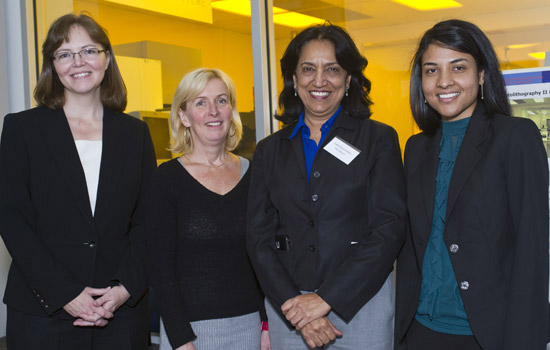RIT to host Microelectronic Engineering Conference
GlobalFoundries learning and development manager Julian Serda and RIT researchers to discuss semiconductor trends
Elizabeth Lamark/RIT Production Services
Archana Davasia, right, an alumna of RIT’s microsystems engineering doctoral program, will be one of the featured presenters at the upcoming Annual Microelectronic Engineering Conference. She is shown here with academic advisers and mentors Santosh Kurinec, second from right; Kris Campbell, left, professor at Boise State University; and Simone Raoux, a researcher at IBM.
Skilled workers will be needed as more companies look to the Rochester area to establish semiconductor and microelectronics industries, two high growth-potential industries in New York state and the U.S.
Rochester Institute of Technology will showcase how it is providing some of the employees-of-the-future for these industries through its microelectronics, electrical and microsystems engineering programs at the 2013 Microelectronic Engineering Conference. The annual research conference takes place 8 a.m.–6 p.m. May 7 in the Xerox Auditorium located in RIT’s Kate Gleason College of Engineering. Presentations for the technical portion of the conference begin at 8:40 a.m. in the auditorium.
The research work being done in the area of tunneling field effect transistors, a recent breakthrough technology being developed at RIT, will be one of several trend-topics discussed at the conference. It will also feature more than a dozen senior research project presentations by microelectronic engineering students.
Invited guests include RIT alumna Archana Devasia ’05, ’11 (electrical engineering, microsystems engineering), Product Yield Analysis Manager at Micron Technologies, as well as Julian Serda, Learning and Development Manager from GlobalFoundries; Chris Hobbs, CMOS Scaling Program Manager at SEMATECH; and David Pawlik, RIT doctoral student in microsystems engineering, who was part of the tunneling field effect transistor research team led by engineering professor Sean Rommel. Student and faculty-researchers from the engineering college will also present poster sessions showcasing recent work and expertise.
The event comes at an opportune time, says Robert Pearson, director of the RIT microelectronic engineering program. Economic development groups are interested in establishing high tech industries, such as semiconductor or solar cell manufacturing companies, in Western New York particularly at the Science Technology Advanced Manufacturing Park under development in Genesee County and the Eastman Business Park in Rochester.
“The conference provides a venue at which regional interests in semiconductor manufacturing and education can come together, learning and discussing the exciting developments in the field—everything from advanced processors, memory chips, very-large-scale integration design, micro-electro-mechanical systems, sensors, solar cells and solid state lighting,” says Pearson. “These are all topics that are of interest as Rochester establishes itself a key resource to these industries.”
More information about the conference agenda, topics, speakers and poster sessions can be found by contacting Sara Widlund at 585-475-6065 or sdw4772@rit.edu.














